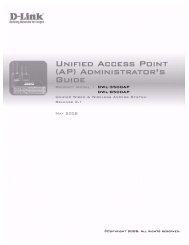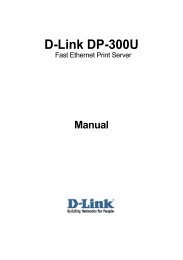Product Manual
Product Manual
Product Manual
You also want an ePaper? Increase the reach of your titles
YUMPU automatically turns print PDFs into web optimized ePapers that Google loves.
DES-3526 / DES-3526DC Fast Ethernet Layer 2 Switch<br />
between client and host as they “exchange keys” in looking for a match and therefore authentication to be accepted<br />
to negotiate encryptions on the following level.<br />
2. Encryption: The second part of the ciphersuite that includes the encryption used for encrypting the messages sent<br />
between client and host. The Switch supports two types of cryptology algorithms:<br />
• Stream Ciphers – There are two types of stream ciphers on the Switch, RC4 with 40-bit keys and RC4<br />
with 128-bit keys. These keys are used to encrypt messages and need to be consistent between client and host for<br />
optimal use.<br />
• CBC Block Ciphers – CBC refers to Cipher Block Chaining, which means that a portion of the<br />
previously encrypted block of encrypted text is used in the encryption of the current block. The Switch supports<br />
the 3DES EDE encryption code defined by the Data Encryption Standard (DES) to create the encrypted text.<br />
3. Hash Algorithm: This part of the ciphersuite allows the user to choose a message digest function which will<br />
determine a Message Authentication Code. This Message Authentication Code will be encrypted with a sent<br />
message to provide integrity and prevent against replay attacks. The Switch supports two hash algorithms, MD5<br />
(Message Digest 5) and SHA (Secure Hash Algorithm).<br />
These three parameters are uniquely assembled in four choices on the Switch to create a three-layered<br />
encryption code for secure communication between the server and the host. The user may implement<br />
any one or combination of the ciphersuites available, yet different ciphersuites will affect the security<br />
level and the performance of the secured connection. The information included in the ciphersuites is<br />
not included with the Switch and requires downloading from a third source in a file form called a<br />
certificate. This function of the Switch cannot be executed without the presence and implementation<br />
of the certificate file and can be downloaded to the Switch by utilizing a TFTP server. The Switch<br />
supports SSLv3 and TLSv1. Other versions of SSL may not be compatible with this Switch and may<br />
cause problems upon authentication and transfer of messages from client to host.<br />
Download Certificate<br />
This window is used to download a certificate file for the SSL function on the Switch from a TFTP<br />
server. The certificate file is a data record used for authenticating devices on the network. It contains<br />
information on the owner, keys for authentication and digital signatures. Both the server and the client<br />
must have consistent certificate files for optimal use of the SSL function. The Switch only supports<br />
certificate files with .der file extensions. The Switch is shipped with a certificate pre-loaded though the<br />
user may need to download more, depending on user circumstances.<br />
To view the following window, click Configuration > Secure Socket Layer (SSL) > Download<br />
Certificate:<br />
Figure 7- 20. Download Certificate window<br />
To download certificates, set the following parameters and click Apply.<br />
134

















